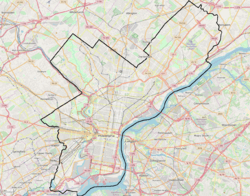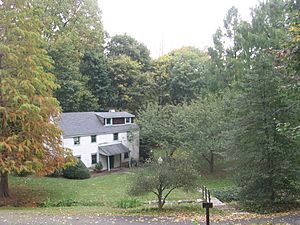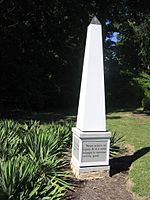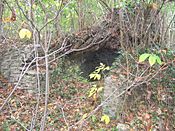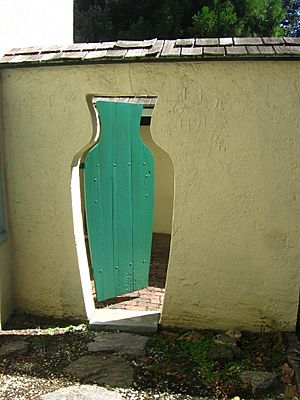Belfield (Philadelphia) facts for kids
|
Charles Willson Peale House
|
|
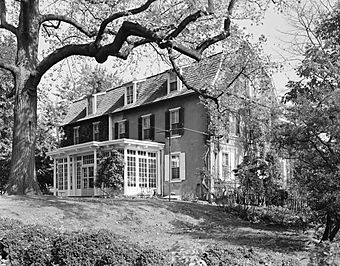
Charles Willson Peale House
|
|
| Location | 2100 West Clarkson Avenue, Philadelphia, Pennsylvania |
|---|---|
| Built | 1755 |
| Architectural style | Dutch Colonial |
| NRHP reference No. | 66000687 |
Quick facts for kids Significant dates |
|
| Added to NRHP | October 15, 1966 |
| Designated NHL | December 21, 1965 |
Belfield, also known as the Charles Willson Peale House, was the home of famous artist and scientist Charles Willson Peale. He lived here from 1810 to 1826. In 1965, it was named a National Historic Landmark. This means it's a very important historical place in the United States.
The Belfield Estate was a large piece of land, about 104 acres, in Philadelphia, Pennsylvania. Today, much of this land is part of La Salle University's campus.
Contents
Discovering Belfield's Early History
In 1684, William Penn, who founded Pennsylvania, gave 588 acres of land near Germantown to Thomas Bowman. Two years later, Bowman sold the land to Samuel Richardson. Richardson was a Quaker and played a role in Pennsylvania's early government. His home, "Newington," was on Old York Road.
When Samuel Richardson passed away in 1719, his son Joseph inherited the land. Joseph divided it among his children. The part that would become Belfield went to his second son, John. In 1731, John Richardson sold some of this land to John Eckstein. The sale papers from 1731 mentioned "Buildings & Woods." This is the first time buildings were recorded on the property. The oldest part of the main house, a square structure now attached to the back, might have been one of these early buildings.
In 1755, Eckstein gave the land where the main house stands to his daughter Magdalena and her husband, Conrad Weber. After Eckstein died in 1763, his remaining children sold their parts of the land to Weber by 1786. We don't know the exact year the main house was built. However, Peale later wrote that a "Dutchman" built it. Since Weber's father was Dutch, the house was likely built after 1755.
Weber sold the property to his tenant, Richard Neave, in 1804. Neave owned it until he died in 1809. Then, it was sold to Charles and Mary Grégoire, who were also tenants. The Grégoires owned it for only three months before putting it up for sale again.
Charles Willson Peale's Home
Charles Willson Peale wanted to retire. He handed over his natural history museum to his son, Rubens. Then, Peale started looking for a small country home. In 1810, he bought the land from Charles Grégoire for $9,500.
Peale first called his new home 'Farm Persevere'. He wrote to Thomas Jefferson that he chose this name because he got it "by labor and perseverance." But Peale's friends thought the name was too serious. So, by 1812, he changed it to 'Bellefield', which later became 'Belfield'.
After buying the property, Peale started making changes to the mansion. He removed walls between rooms. He also added a "painting room" to the north side of the house. This room was damaged in a storm in 1817. After that, a larger, two-story addition was built.
In 1821, Peale and his wife Hannah became sick with yellow fever. Hannah passed away. A weakened Peale moved in with his son Rubens. He then put Belfield up for sale. In 1826, William Logan Fisher, whose estate was next to Belfield, bought the property for $11,000.
Peale's Gardens and Grounds
Peale loved to grow plants and found much inspiration in his gardens. One of the first things he added was a "summer house" around 1813. His son Franklin built it. It was a six-sided building with six columns. A statue of George Washington was on its roof. Later, another family built a gazebo on this spot.
Northwest of the summer house, an obelisk stood at the end of a garden path. Peale painted four mottos on its base. These mottos were important rules for his life. Peale wanted to be buried at the foot of this obelisk. However, he sold Belfield a year before he died, so this wish did not come true. Later, the Wister family buried their dog, 'Kaiser', there. In 2000, a copy of Peale's obelisk was made by La Salle University alumni.
South of the obelisk, Peale built another gazebo. This one was in a "Chinese style" and was a quiet place for thinking. It was simpler, with a flat roof for shade and four posts. On the same hillside, Peale put a stone with ninety important events in American history. These events started with the discovery of America and ended with the American victory at New Orleans in 1815. He even left space for future events, like the first American steamship crossing the Atlantic Ocean.
The property originally had seven natural pools and springs. Peale used these to improve his large garden. He dug out the source of one spring to create an artificial cave. He lined this cave with stone. This spring then fed a greenhouse with a glass roof. Today, only two of the original seven pools remain. The others have disappeared or been moved.
To the southeast, there was a pool with a ten-foot fountain. This fountain got its water from pipes connected to the spring. Next to the pool was a garden shed. Peale painted a "gate" on the shed to make it look different. On this "gate" were symbols representing Congress, America, Truth, Wisdom, Temperance, and Mars, the Roman God of war.
The ruins of Peale's cave and greenhouse can still be seen today. The cave is now under a coffee tree stump, but its old stone walls are visible. The greenhouse walls are mostly covered with plants. The area where Peale's pond was is now a paved driveway.
Peale's gardens and greenhouses were once beautiful, filled with many kinds of plants. There was a fig tree and a box tree near the gardener's cottage. Many transplanted trees were also on the land. One tree that has lasted through the years is an old hickory tree near the greenhouses.
Belfield After Peale's Time
After buying Belfield from Peale, William Logan Fisher and his wife Sarah Lindley Fisher lived there. They had three children. In 1826, William gave the estate to his daughter Sarah when she married William Wister. According to their great-granddaughter, Mary Meigs, Belfield was a stop on the Underground Railroad. However, there is no proof of this from that time.
William Wister and William Logan Fisher started the Belfield Print Works on the property. William Rotch Wister, the Wisters' oldest son, built a house on the estate in 1868 for his family. This house is now La Salle University's Mary and Frances Wister Fine Arts Studio. In 1876, he moved his family to another house he built called 'Wister'.
When Sarah Wister died in 1891, her second son, John, bought the rest of the property. John Wister made improvements to the main house, adding a furnace. He also built a greenhouse next to the ruins of Peale's greenhouse. The foundations of this greenhouse still exist today. In 1907, the carriage house caught fire, but the main house was not damaged.
After John Wister died in 1900, his wife Sallie lived at Belfield until her death in 1922. John's will gave Belfield to his second daughter, Sarah Logan Wister Starr. She had lived in another house on the property since 1901. This caused a long family disagreement between Sarah and her older sister.
During the time Sarah and her husband James Starr owned Belfield, they added bathrooms and underground electricity and phone lines. They also restored the old colonial kitchen. They planted citrus trees and a garden with one hundred Tea Roses. James Starr was interested in China. He added several rock gardens and a "Chinese Garden" behind the main house, which is still there. The date it was built was written in Chinese on the garden wall.
Also during the Starrs' ownership, 20th Street was built. A deep cut was made in the hillside, so a 14-foot wall had to be built along the eastern edge of the estate. In 1926, La Salle College bought some land from the Starrs for $27,500. The rest of the campus land was bought from other descendants of William Logan Fisher.
In 1956, S. Logan Wister Starr and her husband Daniel Blain inherited the mansion. They kept the property as a working farm, even though they spent most of their time in Nova Scotia. In 1966, under the Blains' ownership, Belfield was added to the National Register of Historic Places. La Salle University had been renting 'The Mansion' and another house, 'Shaw Manor', from the Blains for student housing since the early 1960s. In 1968, La Salle bought both houses and later removed them for parking. In 1979, Logan Blain died. Her son, Daniel Blain, Jr., sold the rest of the estate to La Salle University in 1984.
After buying the estate, La Salle University began renovating it. They changed it from a farm into a park-like area. Some buildings were removed, like Peale's stable and hen house. These were taken down to build a parking lot and later tennis courts. The main house of Belfield, now called 'Peale House', became the office for the President of La Salle. The old tenant house on the south end of the property was used for Japanese tea ceremonies from the 1980s until 2007.
Images for kids


